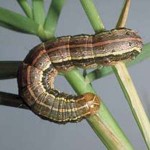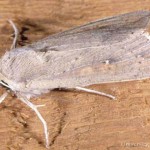Armyworms are grayish brown caterpillars that can grow to 1-1/4 inches. True armyworms appear in the spring, while fall armyworms (see image) appear in August and September following a wet summer. Fall armyworms have a cream-colored upside-down “Y” on the fronts of their head capsules. Small, young (early instar) larvae feed at the base of grass plants turn the tips of grass white from feeding. As the develop, they feed higher on the grass blades, and outbreaks seem to appear almost overnight.
Description
Caterpillars grow to about 2 inches long and are marked with green, brown or black colors arranged in stripes, with darker stripes along the sides. The top of each abdominal segment is marked with two pairs of black dots from which stiff hairs arise. The front of the dark head capsule is marked with a pale colored upside-down “Y.” Adult moths have dark gray mottled forewings marked with light and dark areas. Wings are held over the back of the body when at rest. Outstretched, wings measure about 1 ½ inches from tip to tip. The hind wings are white.
The “true” armyworm, Pseudaletia unipuncta (Haworth) is difficult to distinguish from the fall armyworm in the larval stage. Caterpillars are pale-green to yellowish or brownish-green with bodies that are somewhat wider in the middle. They feed mainly at night, and like the cutworms, may curl up when disturbed. Small, young caterpillars skeletonize the surface of foliage and the inner surfaces of leaf sheaths while larger ones consume leaves, beginning from the outer edges. Host plants include corn, lawn grasses, legumes such as soybeans, small grains and others. Adult moths are predominantly pale brown to grayish brown wings. The center of each forewing is marked with a single small white spot.
Life Cycle
Winter is spent primarily as pupae, although all stages may be encountered during mild winters. Adults emerging in early spring mate, disperse and lay eggs on host plants. Females lay clusters of a hundred or more eggs that are covered with fuzzy, gray scales from the female’s body. Caterpillars hatch from eggs in about 10 days and begin feeding together, first on the remains of the egg mass and then on the host plant. Larvae grow and molt between several stages (instars) over a period of 2 to 3 weeks, before digging a burrow up to 8-inch deep in the ground in which to pupate. The pupa is about ½ inch long, reddish brown to black, smooth and hardened. Adults emerge in about 2 weeks. Several generations can occur annually. It is most common in late summer or fall.
Habitat and Food Source
Caterpillars have chewing mouthparts. Adults have siphoning mouths. Fall armyworms feed on a wide range of plants, including Bermudagrass, corn, fescue, Johnsongrass, rice, ryegrass, small grain crops, sorghum, Sudangrass and timothy. In corn, caterpillars can injure foliage as well as the ears. Caterpillars often occur locally in large numbers and migrate together like an army as they devour host plants, eating all above ground plant parts. They feed at all times of the day or night. In turfgrass, caterpillars may be driven to the surface by sprinkling soapy water onto infested areas. Adult moths are attracted to lights and in pheromone traps.
Natural Enemies/Control
Weather and multiple natural enemies usually act together to keep armyworm populations under control. Parasites such as wasps and flies are very effective against armyworms. Predators, such as ground beetles, are also effective in limiting outbreaks. Birds, skunks and rodents also consume large numbers of larvae and pupae. Diseases such as insect viruses and fungi can also be important.
Pest Status
Caterpillars are commonly encountered in landscape plants and turf and in agricultural fields. They are medically harmless.


